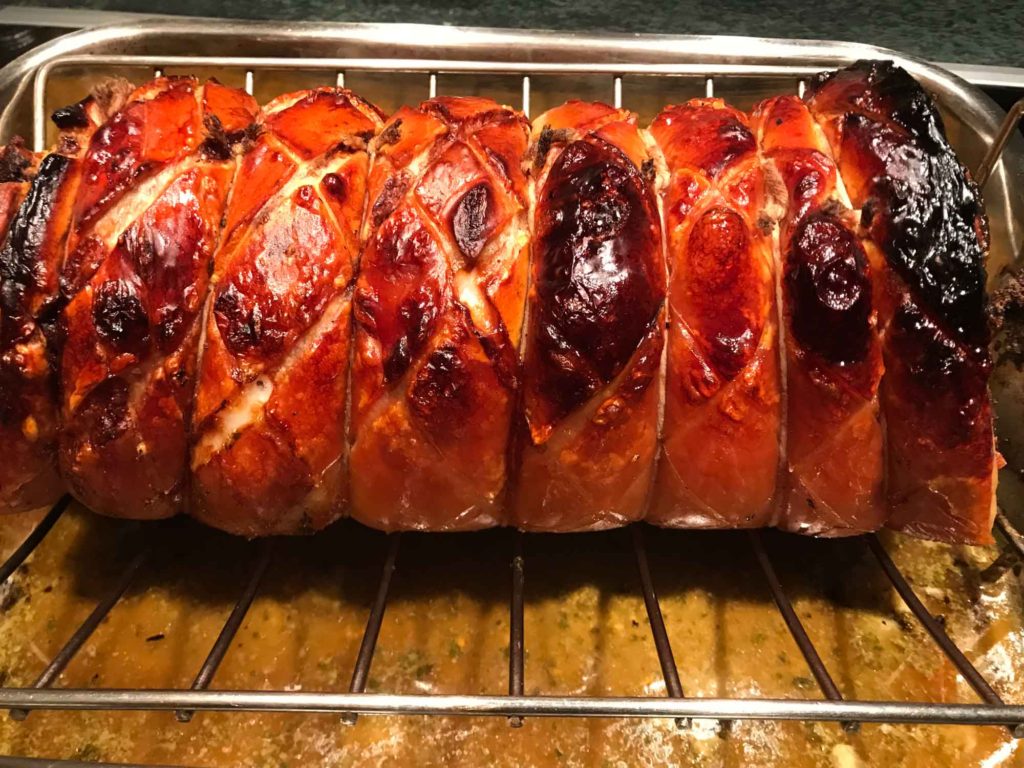
It’s so easy to love a pig. At least from afar – at a personal level, they’re a bit too shrewd to be entirely adorable. They’re not like dogs, who will believe anything you tell them. But if you haven’t seen a pig in a while, take a moment to admire their current physique. The thick layers of lard that once draped their resilient, rubbery bodies have been shrunken to streaks. They look lean, self-satisfied and delicious, like the illustrations on romance novel covers.
We have bred pigs to fulfill our menu fantasies, and it’s worked. Pork belly – aka bacon – is now an actual meat, served in thick slices in ramen bowls and barbecued in various ways as an appetizer. And you can roll it up, with or without the thick, lean loin muscle, into a killer porchetta.
Porchetta is the paragon of the promise of pork. It has become the ideal Big Event meal – incredibly tasty, easy to assemble, forgiving to cook, eye-popping to present and simple to slice. To make it, you really just need a knife, some string, garlic, herbs and salt. The particular version I present here came into my brain when I was considering how nice it was to hit a morsel of pistachio in a slice of mortadella. So why not lots of morsels, and real pork hunks instead of a ground-up paste? Kick it up a notch, as Emeril would say.
The part of porchetta-making that separates the mere diners from the Eaters is that it might involve a butcher, and a tape measure. If you’re going to do this, you might as well go big. Measure the inside length of your largest roasting pan with a rack – it will likely hold a 16 inch piece of pork. Therefore: you need 16 inches of pork belly in one piece, skin on. And to include some lean meat in the roll you need an 8 inch pork loin, which you will then slice down the middle.
There are then three ways to proceed. You might have a butcher (I do) who will serve up what you need, precisely and economically. Or you might have a butcher (I don’t) that regularly brings in whole sides of pork and can cut you a piece my butchers call “English style,” that includes both belly and loin. Or you can Big Box it – buy a full pork belly and loin at one low, low price, and freeze what you don’t use.
The other decisions I’ve made for you here are pretty flexible. Some score diamonds into the skin, some don’t; I’m a scoring fan. I like the charred edges. The pistachio filling is pretty and fun, but the key ingredients are a lot of salt, garlic, pepper and sage. And the thing bastes itself. You can cook fast or slow, so long as the skin winds up crisp and the interior hits 160 degrees F.
You might be looking at all these steps and pictures and waffling a bit about making this dish. Don’t – it’s easy, fun, and hard to screw up. Just think of all those svelte, athletic pigs that were bred just for this moment. Don’t let them down.
Recipe: Pistachio Porchetta
Pork loin and belly stuffed with pistachios, garlic and herbs.
-Full Post-

Lay the pork belly out skin side down. Cut the pork loin in half the long way, so you have two 8" pieces (in the photo I had some mismatched loin pieces, but I think you'll get the idea). Lay the loin along the long edge of the pork belly - the one you will be rolling - to be sure it fits neatly, end to end.
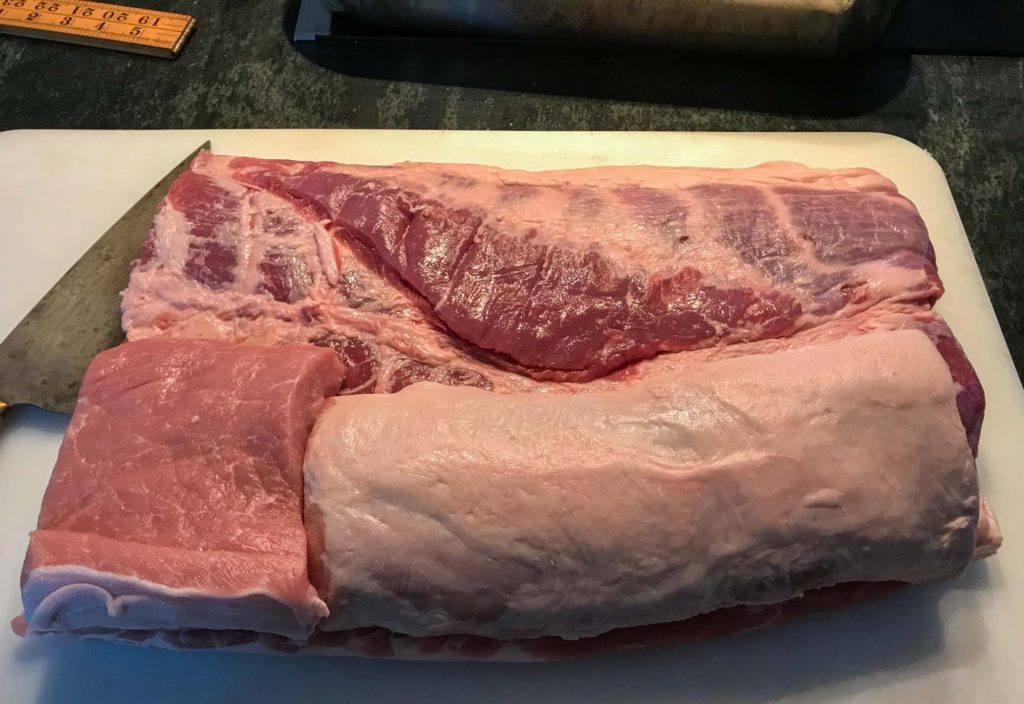
Lay the pork belly skin side up and score the skin in a diamond pattern on the bias at about one inch intervals, about a quarter inch deep. Cut only through the skin, not the flesh. A box cutter with a fresh blade works better at this than almost any kitchen knife. Flip the belly again and try a practice roll with the loin in place. You should be able to tuck up the pork so that the ends of the belly meet.
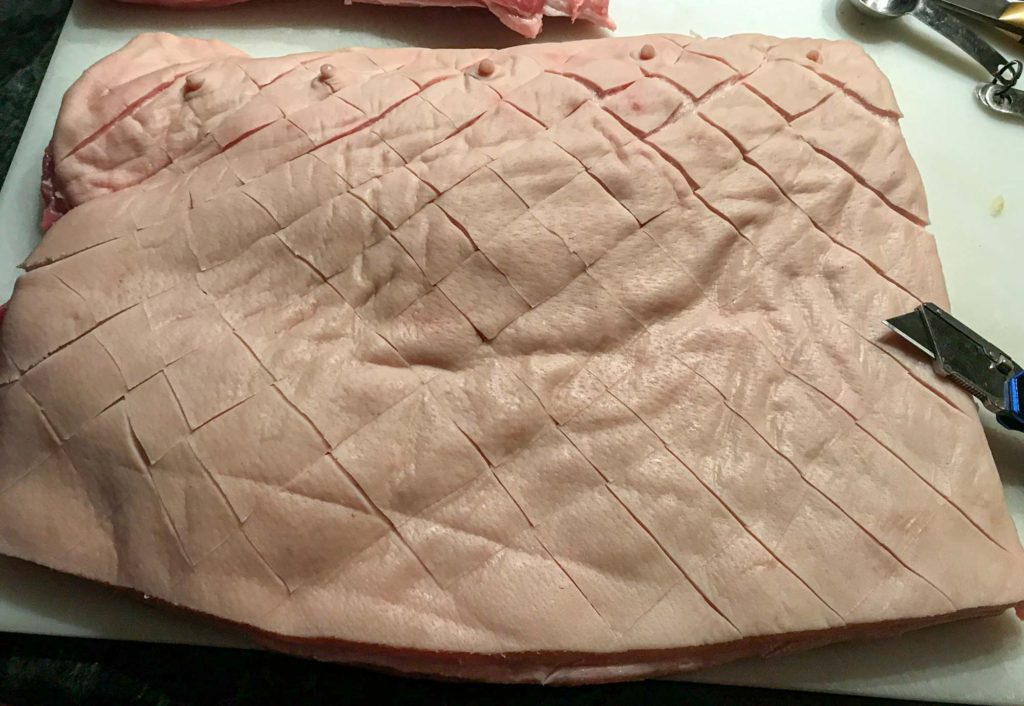
Process the garlic cloves in the food processor. Add the nuts and the salt and process further, pulsing now and then, until you have a rough sand texture. Add the sage, parsley and rosemary. With the processor running (you're basically making a thick pesto), drizzle in the olive oil. Don't let it get too smooth. Stir down as needed with a rubber spatula. Toast the fennel seed, peppercorns and allspice berries in a dry, medium hot pan until fragrant. Blend with the juniper berries, if using, in a spice grinder or mortar and pestle, until powdered. Grate the orange or lemon peel. Add the spices and grated peel to the food processor and pulse once or twice more, just to blend.
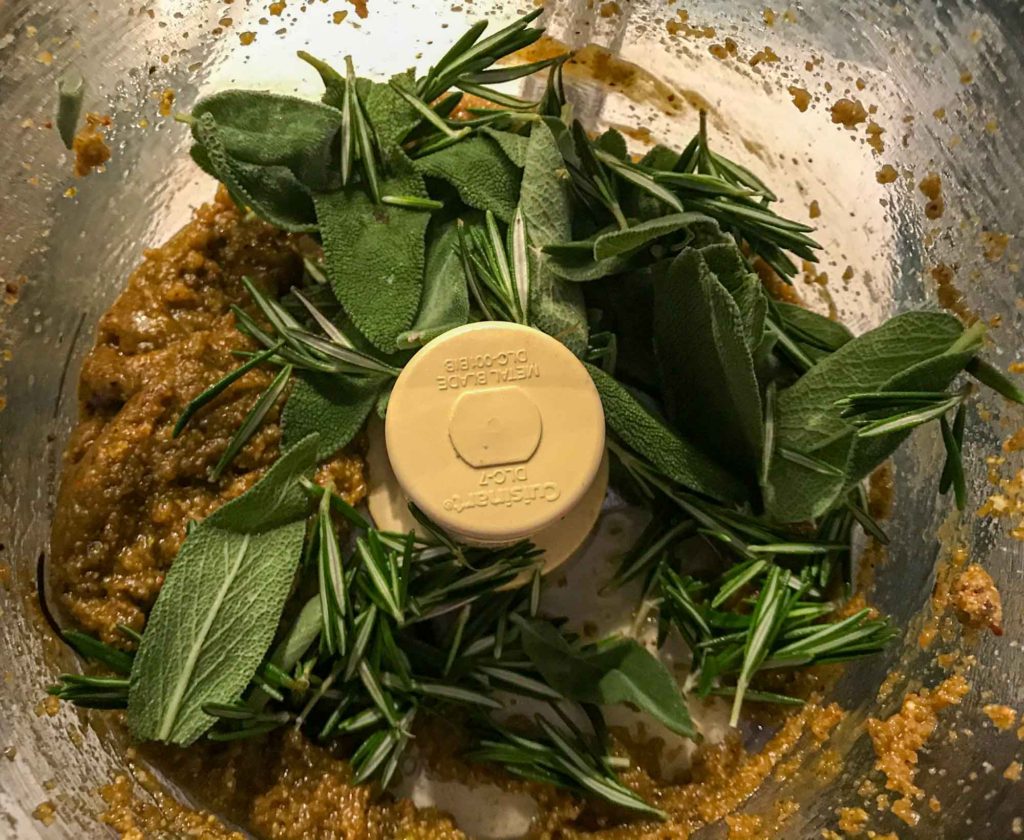
Liberally salt and pepper the inside of the pork belly as well as the loin! Don't omit this step; the paste itself is salty, but not enough to season all that meat from the inside. Spread the herb mixture evenly over the meat, including the area covered by the loin. Roll up tightly from the loin end.
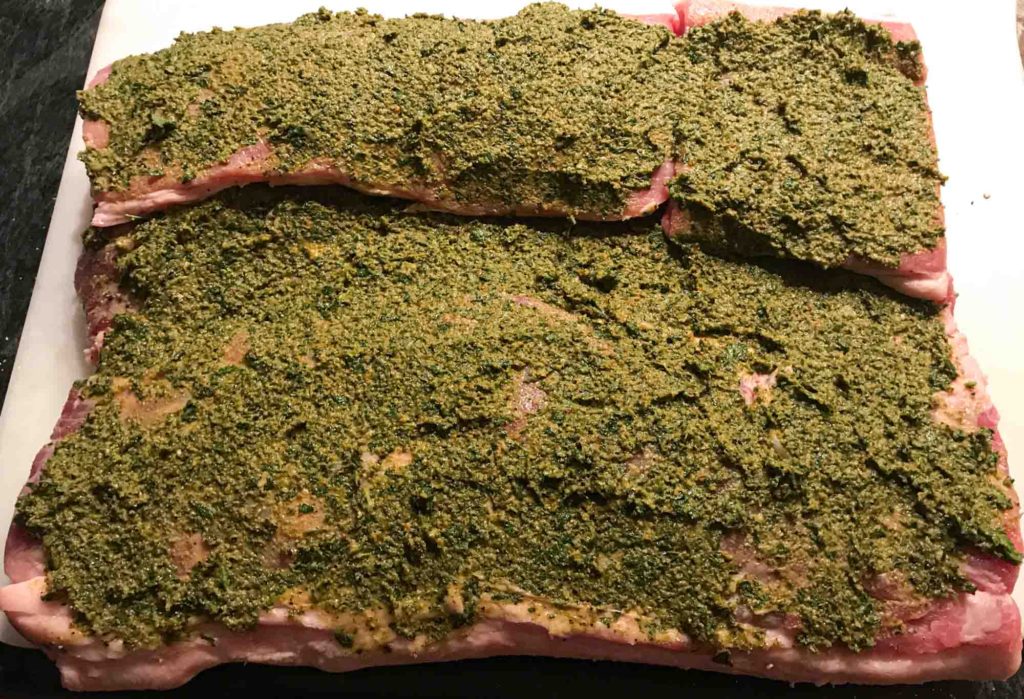
Have some precut pieces of butcher's twine or other clean string in place on the countertop at roughly one inch intervals, and place the roll over the string. Tie up the roll, ends first, as pictured at the top of this recipe. It's ideal at this point to let the pork rest in the fridge, covered in plastic wrap, at least overnight to let the seasonings penetrate the meat. When you're ready to roast, place on a baking rack and put the pan in a preheated oven at 450 degrees F for 30 minutes. Reduce the heat to 300 degrees and pour about a cup and a half of the liquid of your choice (water, white wine, dark beer, black coffee or a mix) on the bottom of the pan to prevent the drippings from burning. Continue roasting for about another 2 hours, checking every half hour so, or until the internal temperature hits 160. Let rest, uncovered or very loosely tented, for at least 20 minutes before serving. Cut about half inch slices onto a platter and serve with pan juices.
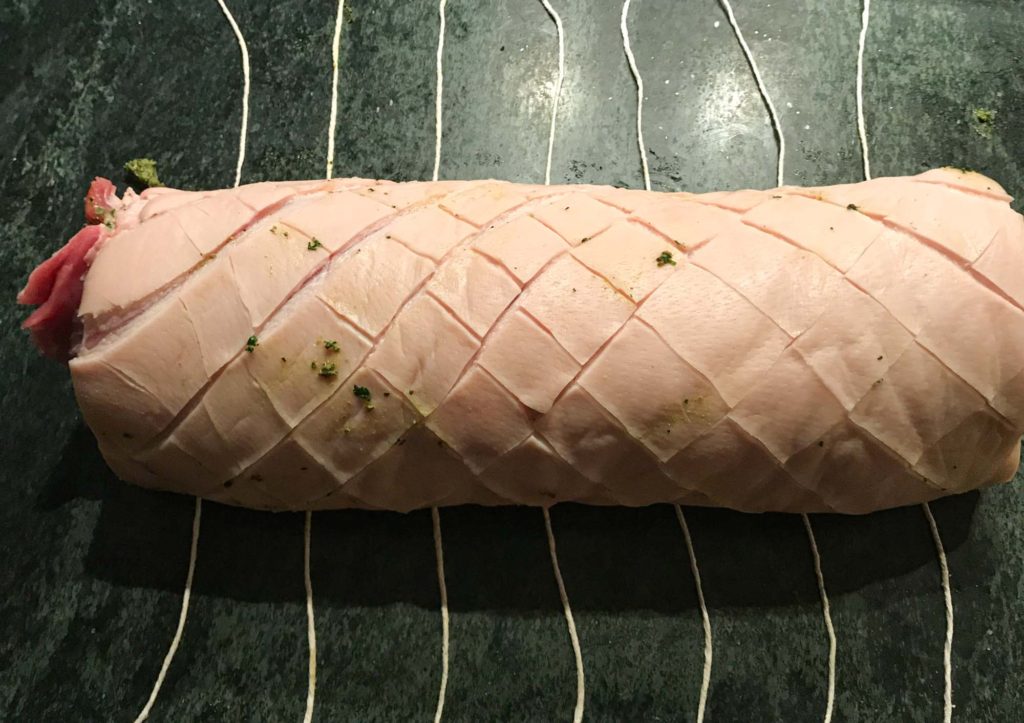
It's fine to buy a lot of cheap meat and freeze what you can't use. You can also just double the filling recipe and make one enormous roll - a full pork belly is around 24" - and freeze the whole thing, stuffing and all, for a month or two. In any case, a chunk of frozen pork belly is one of the nicest things to have around the house.
Don't want to do the nuts? Substitute breadcrumbs or omit entirely.
The reason you tie both ends first is because . . . if you start out at just one end you will squish a lot of filling out the other. Maybe. Anyway, that's what I do.
To cook the porchetta in the picture below, I used my outdoor, wood-fired oven. This is huge fun but less of an advantage than you might think, unless (!) your real goal is to hang around outside and drink beer while pretending to check on things. It's still just basically an oven that starts out at around 450 and then drops 25 degrees every half hour or so. You could also cook this very low and slow, either starting at 300 for a few hours or even overnight at around 225, then raising the temp to 500 to crisp the skin - if you do that, watch it carefully. Also - covering the roast too closely as you let it rest before serving will remove some of that luscious crispness.
I'm a fan of adding dark beer and water, or light beer and black coffee, to the bottom of the pan. I don't find that it softens the skin, and you get great pan juices.

Ingredients
Directions
Lay the pork belly out skin side down. Cut the pork loin in half the long way, so you have two 8" pieces (in the photo I had some mismatched loin pieces, but I think you'll get the idea). Lay the loin along the long edge of the pork belly - the one you will be rolling - to be sure it fits neatly, end to end.

Lay the pork belly skin side up and score the skin in a diamond pattern on the bias at about one inch intervals, about a quarter inch deep. Cut only through the skin, not the flesh. A box cutter with a fresh blade works better at this than almost any kitchen knife. Flip the belly again and try a practice roll with the loin in place. You should be able to tuck up the pork so that the ends of the belly meet.

Process the garlic cloves in the food processor. Add the nuts and the salt and process further, pulsing now and then, until you have a rough sand texture. Add the sage, parsley and rosemary. With the processor running (you're basically making a thick pesto), drizzle in the olive oil. Don't let it get too smooth. Stir down as needed with a rubber spatula. Toast the fennel seed, peppercorns and allspice berries in a dry, medium hot pan until fragrant. Blend with the juniper berries, if using, in a spice grinder or mortar and pestle, until powdered. Grate the orange or lemon peel. Add the spices and grated peel to the food processor and pulse once or twice more, just to blend.

Liberally salt and pepper the inside of the pork belly as well as the loin! Don't omit this step; the paste itself is salty, but not enough to season all that meat from the inside. Spread the herb mixture evenly over the meat, including the area covered by the loin. Roll up tightly from the loin end.

Have some precut pieces of butcher's twine or other clean string in place on the countertop at roughly one inch intervals, and place the roll over the string. Tie up the roll, ends first, as pictured at the top of this recipe. It's ideal at this point to let the pork rest in the fridge, covered in plastic wrap, at least overnight to let the seasonings penetrate the meat. When you're ready to roast, place on a baking rack and put the pan in a preheated oven at 450 degrees F for 30 minutes. Reduce the heat to 300 degrees and pour about a cup and a half of the liquid of your choice (water, white wine, dark beer, black coffee or a mix) on the bottom of the pan to prevent the drippings from burning. Continue roasting for about another 2 hours, checking every half hour so, or until the internal temperature hits 160. Let rest, uncovered or very loosely tented, for at least 20 minutes before serving. Cut about half inch slices onto a platter and serve with pan juices.

It's fine to buy a lot of cheap meat and freeze what you can't use. You can also just double the filling recipe and make one enormous roll - a full pork belly is around 24" - and freeze the whole thing, stuffing and all, for a month or two. In any case, a chunk of frozen pork belly is one of the nicest things to have around the house.
Don't want to do the nuts? Substitute breadcrumbs or omit entirely.
The reason you tie both ends first is because . . . if you start out at just one end you will squish a lot of filling out the other. Maybe. Anyway, that's what I do.
To cook the porchetta in the picture below, I used my outdoor, wood-fired oven. This is huge fun but less of an advantage than you might think, unless (!) your real goal is to hang around outside and drink beer while pretending to check on things. It's still just basically an oven that starts out at around 450 and then drops 25 degrees every half hour or so. You could also cook this very low and slow, either starting at 300 for a few hours or even overnight at around 225, then raising the temp to 500 to crisp the skin - if you do that, watch it carefully. Also - covering the roast too closely as you let it rest before serving will remove some of that luscious crispness.
I'm a fan of adding dark beer and water, or light beer and black coffee, to the bottom of the pan. I don't find that it softens the skin, and you get great pan juices.

